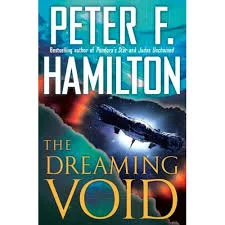Peter F. Hamilton's THE DREAMING VOID
Book review by Dennis D. McDonald
It’s over 1,000 years since the events described in Pandora’s Star. Investigator Paula Myo is still around and is tied into the fractious digital overmind that thinks it rules the galaxy. Unfortunately her personality is more cryptic than ever and she contributes little to the story.
As with other Hamilton novels the number of story lines and characters is vast. Mentally I imagine a huge diagram on Hamilton’s wall with literally thousands of nodes and connections displaying characters, technologies, and events, all coded to indicate in which book each will appear.
There isn’t as much new astonishing technology introduced this time, which is a disappointment. We do have a new faster-than-faster-than-light starship drive technology that attempts to make up for some of the travel delays that were glossed over in earlier Hamilton novels. That’s nice. Plus, one of the most interesting concepts from earlier novels — the rapacious Prime alien culture where multiple physical entities shared the same mind — has been dusted off and applied to human culture to facilitate, among other things, wild sexual orgies.
What hasn’t changed is the vast array of unsavory and unsympathetic characters. In the far future, apparently, the ability to extend physical and mental life almost indefinitely has resulted in the disappearance of compassion, charity, and humanity. Perhaps Hamilton’s message is that, when you do away with the need to regularly replenish the human race with birth and childhood — given that everyone can live so long and can be re-animated after death — you also do away with the traits we often associate with the concept of “humanity.”
The centerpiece of the novel — the shared dream that humanity sees that drives a large semi-religious faction to plan a mass pilgrimage to the center of the Galaxy (the Void) — is the weakest. We are asked to believe that the medieval culture story that runs through the book and apparently makes up the shared dream that is stimulating millions to go on a dangerous pilgrimage to the Void is massively alluring. Those who wield authority believe that this mass pilgrimage will trigger a massive growth in the Void and the resulting destruction of both human and alien civilizations.
That’s a great theme but I have seen nothing that would convince me that the view of the dull and backward magic-dependent medieval culture is actually a view of a desirable paradise. That’s a dramatic problem in this novel’s story that, for me at least, generated both confusion and disappointment about the central conflicts driving the story.
Perhaps this is just a trick on Hamilton’s part that will be explained in the second novel in this trilogy. I hope so. I enjoy Hamilton’s imagination even though his humans are so venal and unappealing. Hopefully some more interesting aliens will show up in the second book to provide greater interest.
Review copyright (c) 2010 by Dennis D. McDonald


